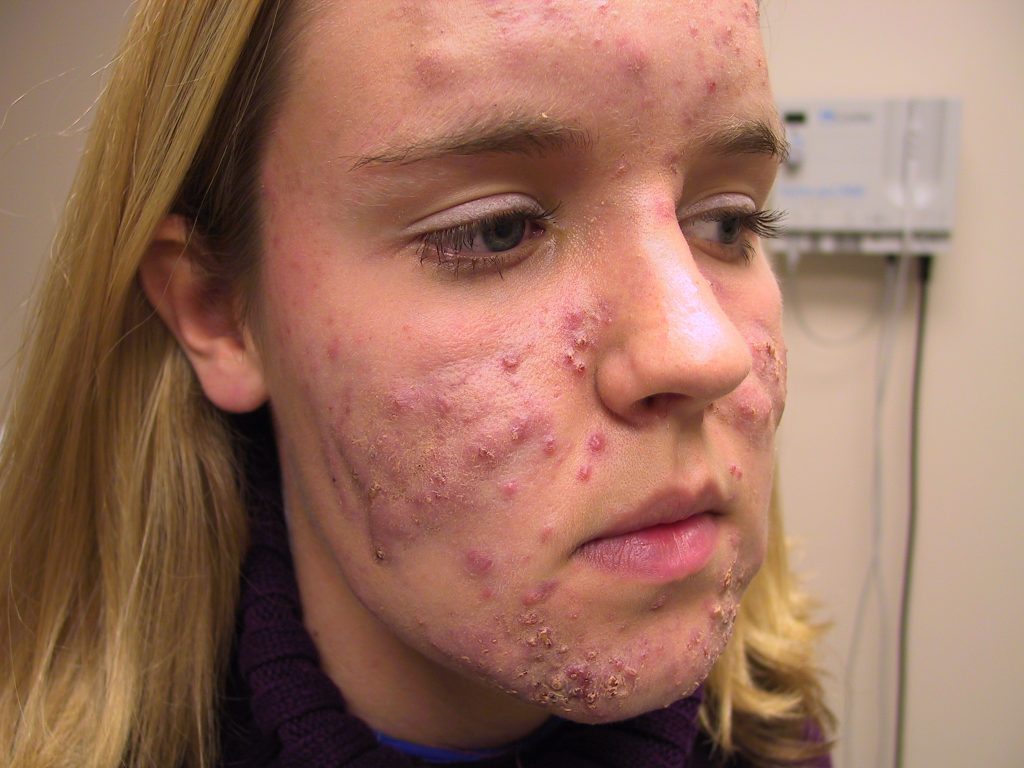Pathophysiology of Acne and acne treatment strategies.
Pathophysiology of Acne and acne treatment strategies.
Acne treatment is always a popular subject in medical journals and women’s magazines. Acne is a broad term for different skin rashes like pimples and deeper pustules, which are clogging pores. In some instances, when the process goes too deep into the skin, acne leaves permanent scars.

Acne is an inflammation of the sebaceous glands as well as hair follicles. This skin disorder usually affects young people during puberty (it is usually between the ages of 10-11 and 24-25 years). While in puberty human’s body produces the uncommonly high level of sex hormones. This upsurge of hormones subsequently happens in both girls’ and boys’ organisms and results in the creation of enormous amounts of sebum (an oily product of the sebaceous glands). This oily component irritates and clogs the pores resulting in blemishes that get infected and convert into boils. Usually after puberty, the level of hormones diminishes however in woman’s body the upsurges of progesterone may happen on a monthly basis after ovulation and as a result, this hormonal “spike” initiates flair up of premenstrual acne.
Acne is a skin ailment that impacts oil glands and hair follicles.

The particular reason for acne is unidentified; however, there are several associated processes that may cause the development of acne.
- Physiological cycles that normally change hormonal production (menstrual cycles, puberty, etc.) hypothetically are accountable;
- Increase of the level of male sex hormone androgens stimulates the production of the sebum by the enlarged sebaceous glands;
- The Same upsurge of progesterone during pregnancy can stimulate acne development;
- Inheritance or genetics is another factor that causes acne. Scientists accept as true that the predisposition for acne may be genetic and may come from either parents or even previous generations;
- Buildup of dead epidermal cells may clog pores and stimulate acne;
- The body becomes allergic to microorganisms that develop colonies in the skin pores;
- Skin injuries, scratches or irritations may activate the inflammation of hair follicles;
- Taking birth control pills changes the hormonal balance;
- Some pharmaceutical drugs;
- Some kind of cosmetics and makeup.
Acne is a comprehensive term that includes different forms of skin rashes. The list of the skin disorders that fall under the term Acne includes:
- Acne vulgaris: usually initiated prior to or during puberty, most common localization – face, shoulders, chest;
- Acne rosacea: A red skin elements mainly on the skin of the face;
- Acne keloidalis nuchae: Acne as a result of shaving with blades;
- Acne conglobate Chronic carbuncles initiated in sweat glands; most common localization – underarms, buttocks, and groin;
- Acne fulminant: The most aggressive form of acne conglobate;
- Acne cosmetic: Skin rash as a result of the use of some type of cosmetics;
- Acne medicamentosa: Acne appears at the beginning of ending of taking some pharmaceutical drugs.
Homeopathic acne treatment.

Sulphur
It is probably the medicine that most commonly designated for acne treatment and other skin problems, especially in chronic form. In order to prescribe Sulphur, homeopath should find the skin bumpy and firm. This acne patient will complain about constipations. Patients who benefit from Sulphur feel aggravation from water and that’s why they prefer to avoid washing face and taking a shower.
Sanguinaria
It is one more beneficial homeopathic medicine for acne treatment, mainly in females with light and short menstruation and unbalanced blood circulation, with areas of stagnation. Other homeopathic medicines for acne that develops as a result of woman’s sexual hormonal misbalance are Calcarea carbonica and Aurum Muriaticum.
Kali Bromatum
Acne that would yield to this remedy located on a face, front and sides of the neck and upper shoulders.
Antimonium crudum
This remedy requires very specific symptoms and generalities:
The Antimonium crudum acnes are always in a form of small pustules
- Acne in patients with alcohol addiction and stomach disorders,
- The patient is dehydrated with white-coated tongue.
- Face with depressed appearance, agitated, annoyed and grumpy;
- Antimonium crudum patient cries when looks, washes or touches acne.
- These patients are also euphoric, pensive, and emotional.
Antimonium Tartaricum.
Stubborn medical cases of acne, with a predisposition to pustulation, are curable with Antimonium Tartaricum.
Natrum Muriaticum
This famous homeopathic remedy pinpoints its power mainly to sebaceous glands and is a very beneficial medicine in acne treatment clinic.
To select Natrum Muriaticum homeopathic physician must focus particularly on the individual’s constitutional signs. Personality, temper, propensities and other common signs are much more significant than the simple topical symptoms.
Belladonna
This remedy is best suited for Acne Rosacea. Rawness and whiteness of the skin replace each other. In Belladonnapatients, skin is dehydrated, hot, inflated and puffy. Pustules mainly localized a skin of a face. A face suddenly turns red and then suddenly pale. Belladonna patients are usually overweight, with blond hair, blue eyes. Their intellectual level is above average. Hahnemann in his Materia Medica mentioned that Belladonna doesn’t work on patients with low IQ. Also, all symptoms in Belladonna patients are acute and they happen unexpectedly.
Comments